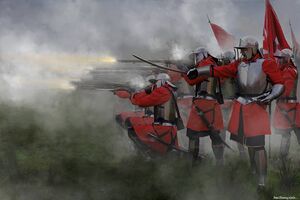Battle of Silla
| Battle of Silla | |||||||
|---|---|---|---|---|---|---|---|
| Part of the Kamalbian War (1550-54) | |||||||
 Imperial Guard Riflemen at the Battle of Silla | |||||||
| |||||||
| Belligerents | |||||||
|
|
| ||||||
| Commanders and leaders | |||||||
|
|
| ||||||
| Strength | |||||||
| 18,000 | 24,000 | ||||||
| Casualties and losses | |||||||
| Light; several hundred | Heavy; est. 2,000 to 4,000 | ||||||
The Battle of Silla was the first victory by the Empire of Exponent over the army of Berique during the Kamalbian War 1550-1554. The battle was especially important because it highlighted the importance of Imperial massed gunfire, which was used to devastating affect against the more mixed Beriquois forces.
Background
Following the defeat at the Battle of Sancte Ligorious, Imperial forces under Quintus Selius were forced to regroup and await reinforcements from Hesperidesia. Once those soldiers arrived, Selius then began to press an offensive, searching for the man body of Beriquois in Kamalbia with the intention of inflicting a decisive defeat.
Battle
Selius met the Beriquois army on a plain outside of the town of Silla, with both sides deploying their troops in typical 16th-century fashion.
The Beriquois army was a mixed force of cavalry, pikemen, and arquebusiers. The cavalry, consisting of heavily armored horsemen and lighter cavalry units armed with lances, was stationed on the flanks of the army. The pikemen formed the center of the Beriquois line, standing in close formation with their long pikes at the ready. Behind the pikemen were the arquebusiers, who were armed with a type of early firearm that was slow to reload but could deliver devastating firepower at close range.
The Empire of Exponent's army, on the other hand, was composed primarily of musketeers arranged in dense formations. The musketeers were armed with the arquebus's successor, a lighter and more mobile firearm that could be reloaded more quickly than the arquebus. The Imperial forces were deployed in a formation known as a "pike-and-shot" formation, with musketeers flanking a central column of pikemen.
The battle began with a cavalry charge by the Beriquois, which was met by a barrage of musket fire from the Imperial forces. The Imperial musketeers opened fire from their tightly-packed formations, shooting volleys of lead shot into the charging Beriquois cavalry. The musket balls penetrated the knights' armor and inflicted heavy casualties on the horsemen, causing them to break and flee.
The Beriquois pikemen then advanced, attempting to break through the Imperial line with their long pikes. However, they were met with a wall of musket fire from the Imperial musketeers, who fired in volleys at the advancing pikemen. The Beriquois pikemen were unable to penetrate the dense musketeer formations and suffered heavy losses.
Despite the withering fire from the Imperial musketeers, the Beriquois arquebusiers continued to fire back, inflicting casualties on the Imperial forces. However, their slow reloading times and the speed of the Imperial musketeers' volleys meant that they were unable to inflict sufficient damage to turn the tide of the battle.
After nearly an hour of back and forth volleying, the Beriquois were forced to retreat in the face of the relentless Imperial gunfire, suffering heavy losses. The Empire of Exponent emerged victorious from the Battle of Silla, with only a few hundred men killed or wounded compared to the estimated 2,000 to 4,000 Beriquois casualties
Aftermath
The Battle of Silla was a decisive victory for the Empire of Exponent, showcasing the effectiveness of their massed gunfire tactics against the more mixed forces of Berique. The battle highlighted the importance of Imperial musketry tactics, which would become a hallmark of their military strategy in future engagements. The victory at Silla set the stage for further Imperial successes in the Kamalbian War, which would eventually lead to the signing of the Treaty of Marqueville and the securing of the southern portion of Kamalbia for nearly half a century. It did not, however, accomplish Selius' intended goal of effectively crushing the Beriquois army in the field, as the bulk of the Beriquois force was able to slip away and regroup near the coast.